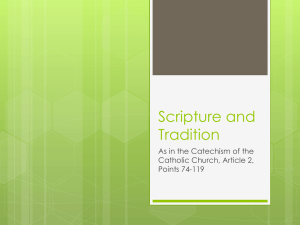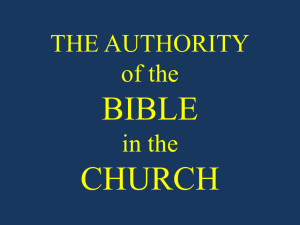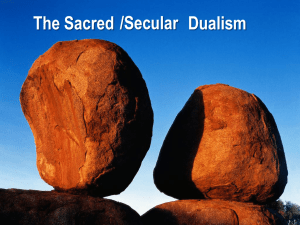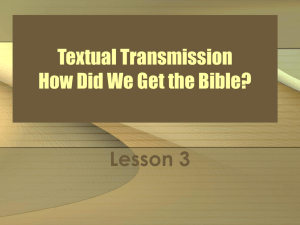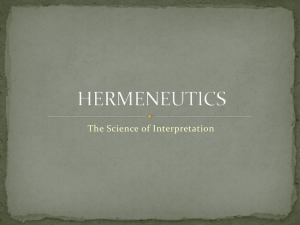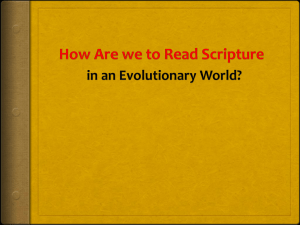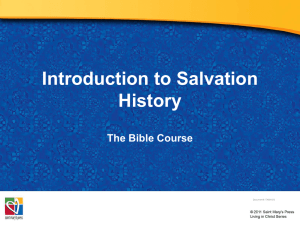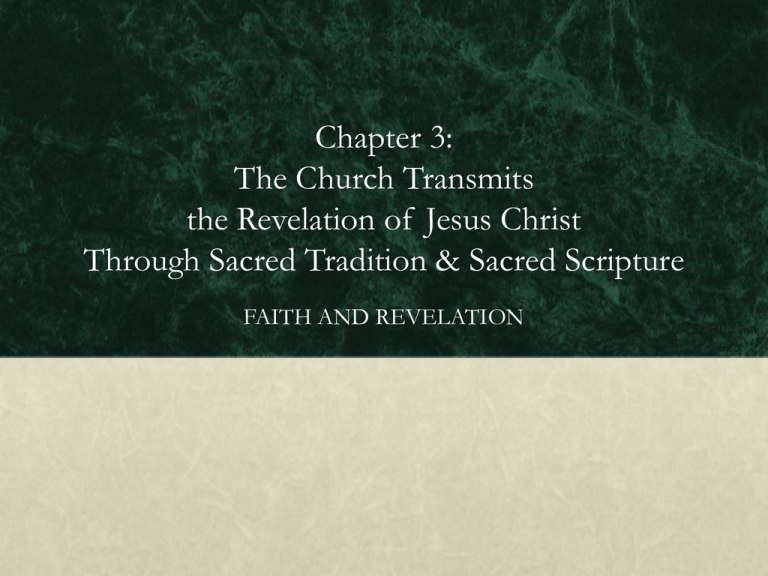
Chapter 3:
The Church Transmits
the Revelation of Jesus Christ
Through Sacred Tradition & Sacred Scripture
FAITH AND REVELATION
1. The Church Transmits the Revelation of
Jesus Christ
BASIC QUESTIONS
Why did Christ establish a Church?
What is the Magisterium?
What is an Ecumenical Council?
What is apostolic succession?
KEY IDEAS
By the power of the Holy Spirit, Christ established a Church under St. Peter and the
Apostles so his Revelation could be preserved in its entirety and be proclaimed to all
nations without corruption.
“Magisterium” is the name given to the universal teaching authority of the Pope and the
bishops in communion with him, which guides the members of the Church without error
in matters of faith and morals through the interpretation of Sacred Scripture and
Tradition.
One way the Church has exercised her Magisterium is through the twenty-one
Ecumenical Councils; this is called the “ordinary Magisterium.”
The Magisterium is preserved through Apostolic Succession, the lineage of Catholic
bishops, including the Pope, through the ages, in which each holds office in a direct link to
the Twelve Apostles.
1. The Church Transmits the Revelation of
Jesus Christ
Anticipatory Set
Work with a partner to create a bullet-point summary of salvation
history based on the first five paragraphs of this chapter.
1. The Church Transmits the Revelation of
Jesus Christ
Focus Questions
What key instrument has God used to transmit salvation history?
Sacred Scripture.
What should our response be to what God reveals?
Faith.
How is the Church a motive of credibility for the truth of Revelation?
It has been faithful to Christ for two millennia despite severe trials.
How is the faithfulness of the Church promised by Christ?
When Christ made St. Peter the visible head of his Church on earth, he said,
“You are Peter, and on this rock I will build my church, and the powers of death
shall not prevail against it” (Mt 16:18).
1. The Church Transmits the Revelation of
Jesus Christ
Guided Exercise
Peruse the objectives listed under “In This Chapter.”
To access your current knowledge, free write for five minutes on the
objective you know the most about.
1. The Church Transmits the Revelation of
Jesus Christ
THE CHURCH TRANSMITS THE REVELATION
OF JESUS CHRIST
Why is it logical to think God would provide a means by which his
Revelation should be fully preserved and transmitted into the
future?
Since the Good News is for all people in all times, it makes sense he
would provide a way for all people to have access to this Revelation.
How did Christ guarantee that his Revelation would reach all
nations unadulterated?
He established his Church and granted his teaching authority to his
Apostles.
What guarantees the Church can infallibly transmit the Faith?
The Holy Spirit.
1. The Church Transmits the Revelation of
Jesus Christ
With respect to his message, when was Christ’s guarantee fulfilled?
It was fulfilled on Pentecost, when the Holy Spirit descended upon the
Apostles.
How was the Apostles’ divine authority confirmed?
By miracles: “Many wonders and signs were done through the apostles”
(Acts 2:43).
When was the infallibility guaranteed to the teaching of the
Apostles first seen?
In the Council of Jerusalem, the Apostles decided the Gentiles did not
have to follow the Mosaic Law. “It has seemed good to the Holy Spirit
and to us” (Acts 15:28).
What was the model for the First Ecumenical Council?
The Council of Jerusalem.
1. The Church Transmits the Revelation of
Jesus Christ
Why is a General Council also called “Ecumenical”?
Bishops gather from around the world; the Greek oikoumene means “the
whole inhabited world.”
With what kind of issues have Ecumenical Councils dealt?
They have addressed theological issues, matters of worship, and Church
discipline.
What was the role of the Ecumenical Council in the early centuries of
the Church?
These councils would served as the primary means by which bishops
discussed and made definitive decisions about theological issues facing the
entire Church.
What are the two key qualities of an Ecumenical Council?
Bishops from local churches around the world and the successor of St. Peter,
the Pope (or his legate), must be present.
1. The Church Transmits the Revelation of
Jesus Christ
Guided Exercise
Think/Pair/Share:
Why are the following questions of utmost importance?
How has the message revealed by Jesus Christ been transmitted down through the
generations?
How can we be sure that it has been handed on faithfully?
1. The Church Transmits the Revelation of
Jesus Christ
What is the sensus fidelium?
The “sense of the faithful” is the whole body of the faithful, who have an
anointing that comes from the Holy One, cannot err in matters of belief.
This characteristic is shown in the supernatural appreciation of the faith
(sensus fidei) of the whole people, when, “from the bishops to the last of
the faithful,” they manifest a universal consent in matters of faith and
morals.
Who guides the People of God in knowing the faith?
The sacred teaching authority of the Church, or Magisterium.
1. The Church Transmits the Revelation of
Jesus Christ
Sidebar: WHAT IS AN ECUMENICAL COUNCIL?
What is an Ecumenical Council?
An Ecumenical Council is a meeting at which bishops from around the world
convene to discuss and debate matters of concern to the whole Church.
Who presides over an Ecumenical Council?
The Pope or his delegate.
What is the effect of decrees of the Magisterium emanating from an
Ecumenical Council?
If ratified by the Pope, they are binding on all Christians.
How many Ecumenical Councils have there been?
Twenty-one (Nicæa I through Vatican II)
1. The Church Transmits the Revelation of
Jesus Christ
THE MAGISTERIUM: THE CHURCH TEACHES
INFALLIBLY
What is the Magisterium?
It is the teaching office of the Church, a work of the Holy Spirit, which
gives the Church the power to transmit Christ’s Gospel faithfully and
without error.
Who constitutes the Magisterium?
The Apostles and their successors, the Pope and the bishops in union
with him.
What does the infallibility of the Magisterium ensure?
The Church cannot teach error in matters of faith and morals.
1. The Church Transmits the Revelation of
Jesus Christ
Who ensures the infallibility of the Magisterium?
The Holy Spirit.
What should be the response of the faithful to a teaching of the
Magisterium when it proposes a doctrine for belief as divinely
revealed?
The definitions “must be adhered to with the obedience of faith.”
Does the Magisterium create doctrine?
No; the Magisterium is an explanatory source of theology. It interprets
Revelation without adding or removing anything from the Good News of
Christ.
Where can examples of the teaching of the Magisterium be found?
It can be found, among other sources, in creeds and the Catechism.
1. The Church Transmits the Revelation of
Jesus Christ
What is the Deposit of Faith?
It describes the whole content of Divine Revelation.
What are the twin sources of the Deposit of Faith?
Sacred Tradition and Sacred Scripture.
How does St. Paul witness to the twin sources of the Faith?
He wrote, “Brethren, stand firm and hold to the traditions which you
were taught by us, either by word of mouth or by letter.” Extension: The
phrase word of mouth refers to Tradition, and by letter refers to Scripture.
How are Sacred Tradition, Sacred Scripture, and the Magisterium
of the Church connected?
They work together and none can stand without the other two.
1. The Church Transmits the Revelation of
Jesus Christ
Guided Exercise
Complete the following graphic to summarize the two ways the
Magisterium exercises the charism of infallibility.
Exercise of
Infallibility
The pope
alone
The bishops
with the pope
Infallibility in the Magisterium
Explanation
1. The Church Transmits the Revelation of
Jesus Christ
Guided Exercise
Complete the following graphic to summarize the two ways the
Magisterium exercises the charism of infallibility.
Exercise of
Infallibility
The pope
alone
The bishops
with the pope
Infallibility in the Magisterium
Explanation
The pope enjoys infallibility in virtue of his office, when, as supreme
pastor and teacher of all the faithful, he proclaims by a definitive act
a doctrine pertaining to faith or morals.
The body of bishops are infallible when, together with the successor
of St. Peter (the pope), they exercise the supreme Magisterium,
above all in an Ecumenical Council.
1. The Church Transmits the Revelation of
Jesus Christ
Insert Sidebar: APOSTOLIC SUCCESSION
How do the contemporary terms “priest,” “bishop,” and “Pope” apply
to the Apostles?
The Apostles were what we would call the first priests and bishops of the
Church, and St. Peter is regarded as the first Pope.
What is Apostolic Succession?
The office of bishop has been passed along in an unbroken continuity from
the Apostles throughout the history of the Church, even to the present day.
How does a person know the present Pope traces his authority directly
to St. Peter?
There is a record of the 266 popes from St. Peter through Pope Benedict XVI.
How did most of the early popes show their fidelity to the Gospel?
1. The Church Transmits the Revelation of
Jesus Christ
Guided Exercise
Think/Pair/Write/Share on the following question:
What does St. Matthew teach about St. Peter’s authority
(cf. Mt 16:18–29)?
1. The Church Transmits the Revelation of
Jesus Christ
Closure
Write a paragraph explaining the relationship between the Church, the
Magisterium, Ecumenical Councils, and Apostolic Succession.
1. The Church Transmits the Revelation of
Jesus Christ
Homework Assignment
Reading
SACRED TRADITION.
FATHERS OF THE CHURCH.
SACRED SCRIPTURE.
Study Questions
Questions 1–8.
Practical Exercise 3.
Workbook
Questions 1–18.
1. The Church Transmits the Revelation of
Jesus Christ
Alternative Assessment
Visit the Vatican’s Web site at the following address:
www.vatican.va/archive/index.htm
Browse the documents of Vatican II to get an idea of the scope of this
most recent Ecumenical Council.
Share what matters you observed that the bishops discussed in council.
2. Tradition and Scripture
BASIC QUESTIONS
What is the relationship between Sacred Scripture and Sacred Tradition?
What is the relationship between Sacred Tradition and human tradition in the Faith?
Where can Sacred Tradition be observed?
Who is the author of Sacred Scripture?
Are the Sacred Scriptures free from error?
Why is Sacred Scripture “sacred”?
KEY IDEAS
Sacred Scripture is that part of Sacred Tradition which was written down under the guidance
of the Holy Spirit.
The Catholic Faith includes both Sacred, or unchangeable, Tradition, and human traditions,
which can change. The Church’s human traditions grow out of her Sacred Tradition.
Witnesses of Sacred Tradition include the Church’s liturgy, the writings of the Fathers of the
Church, and archaeology.
Sacred Scripture has two authors: God, who is its primary author; and inspired human writers,
who faithfully communicated what God wished.
The Scriptures are both veracious and inerrant.
The Scriptures are holy because of their sacred origin, purpose, and precepts.
2. Tradition and Scripture
Anticipatory Set
Read Chapter 67 of St. Justin Martyr’s First Apology, which can be found
online.
Discuss what this reveals about the way the early Church worshipped
God.
2. Tradition and Scripture
SACRED TRADITION
What is Sacred Tradition?
It is the Word of God received from Christ through the Apostles that has
been handed on without alteration by the Church under the protection of
the Holy Spirit.
Why is Tradition called “Sacred”?
The Church receives supernatural assistance from God to transmit the
Gospel.
What Scriptural evidence indicates God gives the Church
supernatural assistance?
Before his Ascension, Christ promised his Apostles, “I am with you
always, to the close of the age” (Mt 28:20), and he told St. Peter, “The
powers of death shall not prevail against [the Church]” (Mt 16:18).
2. Tradition and Scripture
How did St. Paul witness Tradition in his Second Epistle to
Timothy?
He exhorted his disciple St. Timothy to hold fast to the truth he had been
given by the Holy Spirit. St. Timothy should then entrust this truth to
other faithful men who will be able to pass it on to others.
Why is it erroneous to argue that Revelation should be based on
Scripture alone?
Tradition is prior to Scripture both logically and chronologically. The
teachings of Christ were passed on orally at first and then later written
down.
What is the difference between Sacred Tradition and Sacred
Scripture?
Sacred Tradition encompasses the entire Deposit of Faith, while Sacred
Scripture contains the part of Tradition written down.
2. Tradition and Scripture
Sacred Tradition and Human Traditions
What the two kinds of traditions are in the Bible and in the life of
the Church?
There are divine, or Sacred, Traditions, which have God as their author,
and human traditions, which were created by Christians.
Did St. Paul commend the Corinthians for keeping Tradition?
Yes; he praised them because they maintained the traditions he delivered
to them.
What are some examples of the contents of Sacred Tradition?
The divinity of Christ and the mystery of the Blessed Trinity.
2. Tradition and Scripture
What evidence exists that Christ was critical of human traditions?
He accused the Pharisees of being too concerned about traditions of men
and neglecting the Sacred Traditions of God’s Law, saying: “You leave the
commandment of God, and hold fast the traditions of men” (Mk 7:8).
Are there legitimate human traditions in the Church?
Yes.
What is the value and permanence of human traditions in the
Church?
They have a temporary value and can be developed or modified.
Extension: For example, the Church developed the tradition of
plainchant in her liturgy. This did not mean that polyphonic or other
forms of song should not have been introduced in later times.
2. Tradition and Scripture
What are some examples of human traditions in the Church?
Architectural forms and artistic treasures are human traditions.
How do human traditions relate to Sacred Tradition?
The Church’s theological, disciplinary, liturgical, and devotional traditions
grew out of the local churches over time and express Sacred Tradition in
particular historical and cultural circumstances. In the light of Sacred
Tradition, these human traditions can be retained, modified, or
abandoned under the guidance of the Church’s Magisterium.
2. Tradition and Scripture
Sources of Sacred Tradition
What are three sources of Sacred Tradition from the early Church?
Sources include the Church’s liturgies, the writings of the Fathers of the
Church, and archaeological remains. Extension: “Source” in this sense
refers to a witness to Sacred Tradition found in these places; Sacred
Tradition was not created but rather expressed in these sources.
What are the criteria used to recognize someone as a Father of the
Church?
He must be of antiquity, exemplify holiness of life, and be orthodox in his
belief.
2. Tradition and Scripture
Who are the Apostolic Fathers?
They are the earliest Fathers of the Church; they wrote during the first
and at the beginning of the second centuries and were disciples of the
Apostles.
Who are some of the Apostolic Fathers?
St. Clement of Rome, St. Ignatius of Antioch, and St. Polycarp of
Smyrna.
Why do the Fathers of the Church have exceptional doctrinal
authority?
They handed on the Faith received from the Apostles themselves.
2. Tradition and Scripture
Sidebar: Fathers of the Church
Have the students work with a partner to complete the following table
about some Fathers of the Church and why they are famous.
Father of the Church
St. John Damascene
St. Gregory the Great
St. Athanasius
St. Justin Martyr
St. Augustine
St. John Chrysostom
St. Clement of Rome
St. Jerome
Famous
for
A. Being the fourth pope.
B. Defending the icons.
C. Being a great Christian teacher
(died in the fifth century).
D. Preaching eloquently.
E. Being a medieval pope.
F. Translating the Bible.
G. Defeating Arianism.
H. Converting from his life as a pagan
philosopher.
2. Tradition and Scripture
Sidebar: Fathers of the Church
Father of the Church
St. John Damascene
St. Gregory the Great
St. Athanasius
St. Justin Martyr
St. Augustine
St. John Chrysostom
St. Clement of Rome
St. Jerome
Famous
for
B
E
G
H
C
D
A
F
2. Tradition and Scripture
SACRED SCRIPTURE
How does Sacred Scripture relate to Sacred Tradition?
Sacred Scripture is the part of Sacred Tradition written down because of
the inspiration of the Holy Spirit.
Who is the author of Sacred Scripture?
God the Holy Spirit is its primary author, and its inspired, human authors
are also true authors.
To whom is Sacred Scripture entrusted?
It is entrusted to the Church.
2. Tradition and Scripture
a. Inspiration: God Is the Principal Author of Sacred Scripture
Who are the two authors of Scripture?
God and the human writers are both true authors of the Scriptures.
What does it mean to say that God is the author of Sacred
Scripture?
The Holy Spirit did not simply assist the human writers but actually
authored what they wrote. Inspiration is nothing less than divine
authorship.
What effect did God’s inspiration (the divine authorship of
Scripture) have on the Sacred Authors?
It did not in any way diminish the role of the human writers; rather it
enabled them to write the truths revealed by God, who preserved them
from error.
2. Tradition and Scripture
Which Person of the Blessed Trinity is the author of Sacred
Scripture?
Although it is attributed to God the Holy Spirit, like all the works of God,
the inspiration given to the writers was an action of all three divine
Persons of the Blessed Trinity.
What does it mean to say a Gospel is “according to St. Mark”?
The Holy Spirit inspired St. Mark to write an account of Christ’s life, i.e.,
a Gospel.
2. Tradition and Scripture
Guided Exercise
Complete a Focused Reading on the paragraphs “As Pope Leo XIII
taught…” and “The divine action of inspiration…” (p. 68) using the
following question:
What is meant by the word “inspired” in these paragraphs?
2. Tradition and Scripture
b. The Supernatural Content of the Bible
How is the Bible “supernatural”?
It has a supernatural origin, God, and it has supernatural content, the
wisdom of God.
What are the two types of truth revealed in the Bible?
God has revealed supernatural truths about his intimate life and the
eternal decrees concerning human salvation. He has also revealed natural
truths people could reach through reason but he wished to make known
easily, with absolute certainty, and without error.
2. Tradition and Scripture
c. The Veracity and Inerrancy of Sacred Scripture
Guided Exercise
Work with a partner to write a bullet-point summary of this section of
the lesson.
2. Tradition and Scripture
d. The Sanctity of Sacred Scripture
To what does the sanctity of the Bible refer?
It refers to the moral perfection of the doctrine contained in it.
What are the three aspects of the sanctity of the Bible?
They are its divine origin, its purpose, and its precepts.
How is the Bible holy in its divine origin?
In Scripture, evil is rejected and good is upheld.
2. Tradition and Scripture
How is the Bible holy in its purpose?
Its purpose is the salvation of all. The New Testament explicitly reveals
the channels of grace Christ instituted by which every person can become
holy.
How is the Bible holy in its precepts?
The Old Testament reveals precepts of the natural law and moral law. In
the New Testament Christ perfects the moral precepts of the Old
Testament by declaring their true meaning, establishing the best way of
fulfilling them, and teaching his disciples how to achieve greater sanctity.
2. Tradition and Scripture
Closure
Write a paragraph summarizing what this lesson teaches about the
relationship between Sacred Scripture and Sacred Tradition.
2. Tradition and Scripture
Homework Assignment
Reading
INTERPRETING SACRED SCRIPTURE.
LITERARY FORMS IN SACRED SCRIPTURE.
THE DIFFERENT SENSES OF THE BIBLE.
Sidebar: HOW TO INTERPRET THE BIBLE.
Study Questions
Questions 9–17.
Practical Exercise 2.
Workbook
Questions 19–28.
2. Tradition and Scripture
Alternative Assessment
Free write for five minutes on some aspect of this lesson that you did not
understand to gain a greater comprehension.
Share responses.
3. Fundamentals in
Interpreting the Scriptures
BASIC QUESTIONS
What literary forms are found in the Scriptures?
What are the four senses in which a scriptural passage may be
interpreted?
What global factors must be taken into account in interpreting the Bible?
KEY IDEAS
One factor that must be taken into account in order to understand a passage of
the Bible is the literary form in which it is written, for example, history, law,
prophecy, apocalyptic, wisdom literature, poetry, or an epistle.
Every passage of Scripture can be read in a literal sense, with which it should be
read. Many passages also can be read in the spiritual sense, whether allegorical,
moral, or anagogical.
When interpreting Scripture we must keep in mind the intention of the human
and divine authors, the content and unity of the whole of Scripture, the living
Tradition of the Church, and the analogy of faith.
3. Fundamentals in
Interpreting the Scriptures
Anticipatory Set
[Jesus] opened his mouth and taught them, saying… “You have heard that it was
said, ‘You shall not commit adultery.’ But I say to you that every one who looks at
a woman lustfully has already committed adultery with her in his heart. If your
right eye causes you to sin, pluck it out and throw it away; it is better that you lose
one of your members than that your whole body be thrown into hell. And if your
right hand causes you to sin, cut it off and throw it away; it is better that you lose
one of your members than that your whole body go into hell” (Mt 5:27–30).
Pornography is prevalent today and involves looking at a member of the
opposite sex lustfully and often causes a person to sin further by self-abuse.
Do you think Our Lord is saying that rather than do these things one
ought to blind oneself and chop off one’s hands?
If you have a problem with this interpretation, on what principles would
you reject it?
3. Fundamentals in
Interpreting the Scriptures
INTERPRETING SACRED SCRIPTURE
Why can there be no contradiction among the passages of Sacred
Scripture?
God is the author of the entire Bible.
What is the nature of an apparent contradiction between two
passages of Scripture?
It is improperly interpreted or understood; otherwise, there is no
contradiction.
3. Fundamentals in
Interpreting the Scriptures
Guided Exercise
Complete a Focused Reading of the paragraph beginning “Since Sacred
Scripture…” using the following question:
Why is it necessary to know the Catholic Faith in order to interpret Scripture
properly?
3. Fundamentals in
Interpreting the Scriptures
LITERARY FORMS IN SACRED SCRIPTURE
What aspects of history does Scripture reveal?
The Bible narrates historical events as well as the divine meaning and
theological purposes of those events.
The Bible is free from error. What does this not guarantee?
It does not guarantee individuals can interpret it correctly.
How can modern standards of analysis be abused with the books
of the Bible?
We might miss the sense that was intended by the Holy Spirit and
expressed by the Sacred Authors. Most of the books were written
between 2000 and 4000 years ago, and the literary techniques then are
different than modern authors employ.
3. Fundamentals in
Interpreting the Scriptures
What are some factors to be considered to understand the intent of the human
author of a book of the Bible?
The conditions of the time and culture; the literary forms used at the time; and the
customary and characteristic patterns of perception, speech, and narrative must be
considered.
What is a literary form?
It is a style of writing that communicates a message through a particular means of
expression.
What are some literary forms found in Sacred Scripture?
They include historical, juridical, prophetic, apocalyptic, wisdom, poetry, and epistle.
Is the Book of Genesis a collection of fictional stories?
No. These events occurred; however, they are told to us in a way that makes the
importance or the meaning of what happened most apparent.
3. Fundamentals in
Interpreting the Scriptures
What is a good method to begin to understand a book of the Bible?
It is best to try to understand the literal sense first. The literal sense is the meaning
intended by its author.
What are some literal questions to ask of a story?
Who is in the story? What happens in the story? Why does the action happen? What
is the result of the action?
How does a literal approach to the Book of Revelation help the reader
understand the use of lamp stands and bowls?
We do not know if these objects exist in Heaven, but their use in the context of the
book shows they figuratively draw connections in the minds of the readers to sacred
objects and elements of liturgical worship.
How does a literal approach to the creation narratives in the Book of Genesis
help the reader to understand the author’s intention?
The unfolding of creation indicates creation itself is to be seen as a temple for the
worship of God.
3. Fundamentals in
Interpreting the Scriptures
Guided Exercise
Work with a partner to answer the following question, using both the text
and the Vocabulary section at the end of this chapter.
What is the difference between a literal and a literalistic reading of a text?
3. Fundamentals in
Interpreting the Scriptures
What are the two literary senses of Sacred Scripture?
They are the literal and the spiritual.
Which of the two literary senses is primary?
The literal is primary because every part of Scripture has a literal sense.
What is the literal sense?
The literal sense is everything that the Holy Spirit intended to express
with the words themselves.
3. Fundamentals in
Interpreting the Scriptures
What is an example of the literal sense of a biblical passage?
“God created the heavens and the earth” (Gn 1:1) means that God
created everything out of nothing.
What is the proper literal sense?
It is the direct or ordinary meaning of the words.
What is the improper literal sense?
This sense understands words when taken in their figurative or
metaphorical meaning.
3. Fundamentals in
Interpreting the Scriptures
b. The Spiritual Sense
What is the spiritual sense?
This interpretation of Scripture sees people and events as signs of something
that goes beyond them.
Why is it possible for the Old Testament to have a spiritual sense even
though it was written over thousands of years by different Sacred
Authors?
Because God is the author of both the Old and the New Testaments and he
is infinitely wise, he could have disposed the events and words of the Old
Testament so things of the past typified, or prefigured, those to come in the
New Testament.
Are all senses present in every passage in the Bible?
The proper literal sense is always present. The improper literal and the
spiritual senses may or may not be present in each passage.
3. Fundamentals in
Interpreting the Scriptures
What is the allegorical sense of Scripture?
People and events in salvation history point forward to other times.
Extension: This is also called the typological sense.
What is the moral, or tropological, sense of Scripture?
It sheds light on people and events so the heroes of Scripture can be seen
as a pattern for their own lives to do good and avoid evil.
What is the anagogical sense of Scripture?
It shows how the events of Scripture point to what will be known in
Heaven.
3. Fundamentals in
Interpreting the Scriptures
Sidebar: HOW TO INTERPRET THE BIBLE
How can we discover a Sacred Author’s intention?
We must take into account the conditions of the Sacred Author’s time and
culture; the literary genres in use at his time; and his modes of feeling,
speaking, and narrating.
What three criteria did the Fathers of the Second Vatican Council
indicate to help interpret Scripture correctly?
One should pay attention to the content and unity of the whole of
Scripture, the living Tradition of the Church, and the analogy of faith.
What is the analogy of faith?
It means the coherence of the truths of the Faith among themselves and
within the whole plan of God’s Revelation.
3. Fundamentals in
Interpreting the Scriptures
Closure
Write a paragraph summarizing what you consider the three most
important factors in interpreting the Scriptures.
3. Fundamentals in
Interpreting the Scriptures
Homework Assignment
Reading
HOW TO READ THE BIBLE.
CONCLUSION.
Study Questions
Questions 18–21.
Practical Exercises 1 & 4.
Workbook
Questions 29–40.
3. Fundamentals in
Interpreting the Scriptures
Alternative Assessment
Complete the following table to organize your understanding of the
various senses in which Scripture can be interpreted.
Sense
Literal
Proper
Improper
Metaphor or
simile
Hyperbole
Parable
Allegory
Fable
Spiritual
Allegorical
Moral
Anagogical
Literal and Spiritual Senses of Scripture
Definition
Example
3. Fundamentals in
Interpreting the Scriptures
Literal and Spiritual Senses of Scripture
Definition
Sense
Literal
Example
The meaning of words in their literary and
historical context.
“In the beginning, God created
the heavens and the earth.”
Proper
The words are understood according to
their ordinary meaning.
“Male and female he created
them.”
Improper
The words are understood figuratively and
symbolically.
(Any of the five senses below.)
Metaphor or A comparison.
simile
Hyperbole An exaggeration.
Parable A story illustrates a moral or spiritual
Jesus is the Lamb of God.
Abraham’s descendants will be
as numerous as the grains of
sand on the seashore.
The Prodigal Son.
truth.
Allegory A prolonged metaphor.
Fable A story with animals or plants as
characters that illustrates a moral or
spiritual truth.
The story in Judges of the trees
wanting a tree‐king to rule over
them.
Allegorical
It is the sense in which people and events
in salvation history point forward to other
times.
The water which flows out of
the Temple of the New
Jerusalem represents grace and
the sacraments.
The sacrifice of Isaac
foreshadows the sacrifice of
Christ on the Cross.
Moral
It is how we can use the things the heroes
of Scripture did as a pattern for our own
lives to do good and avoid evil.
It shows us how the events we see in
Scripture point upward to what we will
know in heaven.
Samson lost all his strength
because he consorted with a
pagan woman.
The garden of Eden and the
Promised Land are indicators of
what heaven will be like.
Spiritual
Anagogical
The people, things, and events Scripture
describes are seen as signs of something
else.
The Good Shepherd and the
hireling.
4. How to Read the Bible
BASIC QUESTION
How should we go about reading the Bible?
KEY IDEA
We should read the Bible under the Church’s guidance, beginning with
the more accessible books, in a spirit of prayer, and with faith.
4. How to Read the Bible
Anticipatory Set
Inasmuch as many have undertaken to compile a narrative of the
things which have been accomplished among us, just as they were
delivered to us by those who from the beginning were eyewitnesses and
ministers of the word, it seemed good to me also, having followed all
things closely for some time past, to write an orderly account for you,
most excellent Theophilus, that you may know the truth concerning the
things of which you have been informed. (Lk 1:1–4)
Why might the Gospel According to St. Luke be a good place to begin to
read and study the Bible?
4. How to Read the Bible
HOW TO READ THE BIBLE
Look to the Church for guidance
How does the Bible show us how to interpret itself ?
Christ granted his teaching authority, or Magisterium, to the Apostles,
who then handed on this authority to their successors, the bishops.
Therefore, the Scriptures indicate people should look to the Magisterium
to help interpret the Bible.
What twofold apostolic authority do bishops possess to understand
the Bible?
This authority consists of (1) the Church’s long study of the truths of the
Faith and (2) the supernatural assistance of the Holy Spirit as the teachers
of the Church.
4. How to Read the Bible
Can each bishop interpret the Scriptures without error?
No; this authority belongs to the Church as a whole, not an individual
bishop.
What is one of the best resources available to understand how the
Church interprets Scripture?
In the Catechism of the Catholic Church, many doctrines of the Church are
explained; it is replete with quotations from Sacred Scripture and the
Fathers of the Church, local and Ecumenical Councils, and the saints of
the Church.
4. How to Read the Bible
What to read first
Why is it true to say the more familiar we are with the many parts
of the Bible, the richer our reading of it becomes?
Every part of the Bible exists in reference to other parts of the Bible.
What is a good place to start to study the Bible?
St. Luke’s Gospel is a good place to start because he is a great storyteller
and his Gospel was written especially for people who knew little about
Jewish customs and traditions.
4. How to Read the Bible
Guided Exercise
Work with a partner to perform a Paragraph Shrink on the paragraph
beginning “Genesis and Exodus…”
4. How to Read the Bible
Pray
Why is it important to pray before reading the Bible?
God is the perfect guidance to benefit from his Word.
In what context is Scripture best understood?
It is best understood within the context of a life of prayer.
Faith
Why is faith the essential condition to read the Bible?
Faith provides the right dispositions to read the Bible. Because of the Fall
and the resultant pride and darkened intellect, a person may not want to
understand what the Bible really teaches.
4. How to Read the Bible
Guided Exercise
Perform a Focused Reading on the paragraph beginning “The Church
allows…” using the following question:
How does attending Mass regularly help a person understand the Scriptures?
4. How to Read the Bible
CONCLUSION
Guided Exercise
Create a bullet-point summary of this conclusion, using no more than
one point per paragraph.
4. How to Read the Bible
Closure
Write a paragraph summarizing how you should go about becoming more
acquainted with the Bible.
4. How to Read the Bible
Homework Assignment
Study Questions
Questions 22–26.
Practical Exercise 5.
Workbook
Questions 41–48.
4. How to Read the Bible
Alternative Assessment
In a small group, read your assigned four Mass readings (First Reading,
Responsorial Psalm, Second Reading, and Gospel) and identify ways in
which the Scriptural selections reinforce and illuminate each other.
The Mass readings can be found in a hand missal or online:
www.usccb.org/nab/
The End

